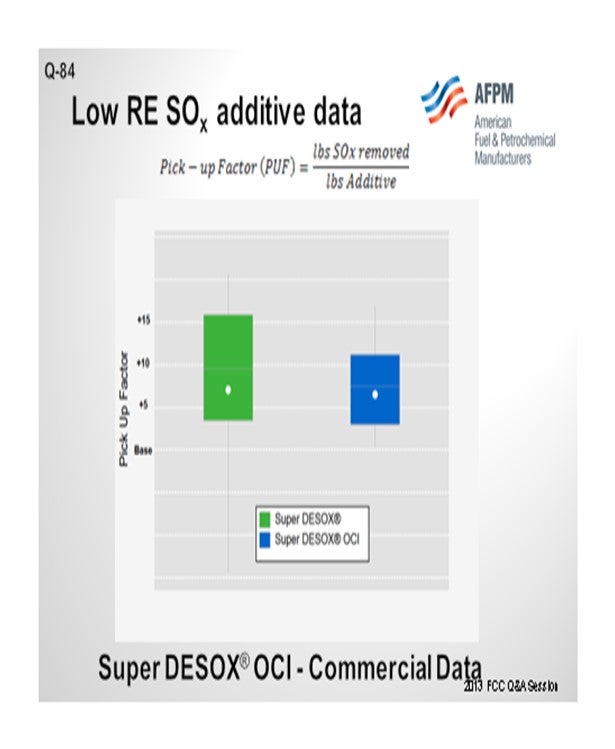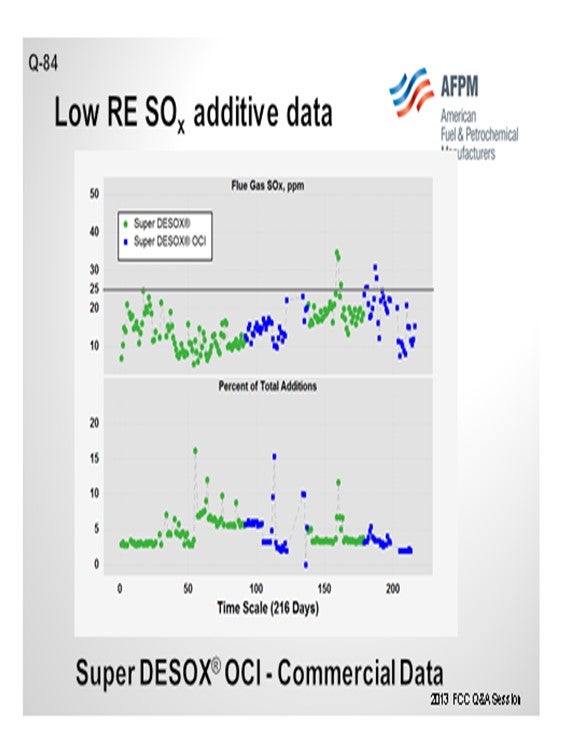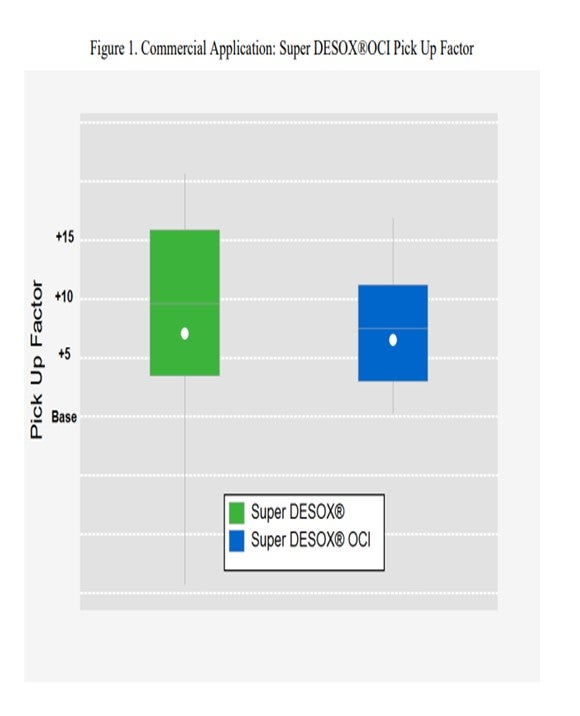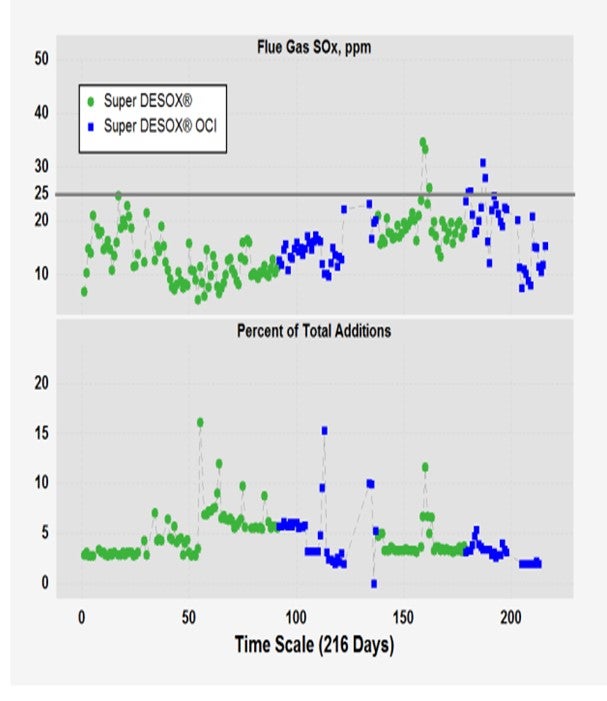Question 84: What are the commercial experiences with low rare earth and zero rare earth SOx reduction additives? What are the incentives to return to traditional products now that rare earth prices have returned to historical levels?
KOEBEL (Grace Catalysts Technologies)
During the run-up in the cost of rare earth in 2011, Grace embarked on an expedited and extensive R&D (research and development) program to develop future generations of our Super DeSOx® additive to cut the rare earth content and try to minimize the financial impact that the ever-increasing cost of rare earth had on our customers’ cost of SOx compliance. The data I am showing on the slide is for our first-generation low-rare earth SOx additive called Super DeSOx®-OCI or optimized cerium input. This data is representative of a single trial, but I think it is reflective of our broader experience that the Super DeSOx®-OCI, with its lower cerium input, had an equivalent performance to that of traditional Super DeSOx®. The information presented here is the trial data on a pick-up factor basis of pounds of SOx removed from the flue gas divided by the total pounds of SOx additive used. You can see that the two additives are essentially equivalent.

The next slide shows the broader, expanded data from that six-month trial. You can see that the refinery switched back and forth between the two additives once or twice. On the percentage of daily addition basis, the SOx additive used was essentially at cost. The refiner was able to readily maintain its 25 ppm SOx emissions limit. So, we have had good experience with Super DeSOx®-OCI, our first-generation additive, and it has gained wide market acceptance.

As rare earth costs continued to escalate, we developed a second-generation low-rare earth SOx additive called Super DeSOx®-MCD or maximum cerium dispersion. Once we got the rare earth content down that low, there was a performance deficit for that additive. Generally, you had to add about 20% more additive. When rare earth was extremely expensive on a cost-per-day basis, adding a little more additive was well worth the cost. But as rare earth prices have now returned to historical levels, Super DeSOx®-OCI, our first-generation low-rare earth SOx additive, is our lowest cost-compliance additive.
The question was: What are the incentives for returning to your traditional Super DeSOx™ additives now that rare earth prices are low? Generally speaking, even though the performance is about the same, our Super DeSOx-OCI™ is a moderately lower-cost additive; so, we do not see a lot of incentive to return to the original Super DeSOx™ additive, except in very rare cases.
MARTIN EVANS (Johnson Matthey INTERCAT, Inc.)
When we introduced Super Soxgetter-II™ with about 8.0% rare earth, we were a little unsure what to expect. However, we found that as we gradually replaced all of the Super Soxgetter™ being used out there, overall the performance actually picked up in full-burn units by about 15%. That makes sense when you think about it. Consider full-burn units in which SOx additive efficiency is generally limited by the amount of magnesium that you can get into the units to pick up the SO2. When you take out the cerium, you end up replacing it with magnesium. Overall, the efficiency of Super Soxgetter-II™ actually ended up about 15% higher because of that slight increase in the magnesium content. It was not an effect we expected, but we were very pleased to see it. We do now also have Super Soxgetter-III™ out there, which has taken the cerium content down to 4%, and the performance remains about the same As Jeff mentioned, since the rare earth prices have declined right now, I think the incentive to go that low really is not there anymore. The manufacturing cost on that product is actually slightly higher; so today, it is not really an economic option for most people. But should rare earth prices increase again, we do have that product ready to go.
KEN BRUNO (Albemarle Corporation)
We continue to find that our zero rare earth products are highly effective in SOx reduction. In fact, our latest and newest innovation – SOxMaster-2™ – has been proven successful in several commercial trials. Again, please refer to the Answer Book for addition details.
JEFF KOEBEL (Grace Catalysts Technologies)
During the early phase of the run up in rare earth prices in 2011, Grace started an accelerated R&D effort to develop a new SuperDESOX® product with a lower rare earth content to minimize the financial impact on our customers. The first of the newly developed products was SuperDESOX®-OCI, or optimized cerium input. The effectiveness of these new additives can be measured by the SOx pickup factor, or PUF. This is defined as the pounds of SOx removed from the flue gas divided by the pounds of SOx additive used. In multiple commercial trials, SuperDESOX®-OCI proved to have equivalent PUFs to traditional SuperDESOX®. The total pounds of additive required to maintain a constant SOx emissions target is thus the same for both additives. Figure 1 illustrates in a commercial example where Super DESOX®-OCI has an equivalent pickup factor as does traditional Super DESOX®.

The refinery also maintained target SOx flue gas emission below the 25 ppm level (Figure 2). With its lower rare earth input, SuperDESOX®-OCI was clearly the lower cost option. This product gained wide market acceptance quickly.

As the cost of rare earth continued to climb, Grace developed SuperDESOX® MCD, or maximum cerium dispersion. This product further reduced the rare earth content of the additive to below the level of even SuperDESOX®-OCI. With rare earth inputs lowered so dramatically, there is a performance effect on the additive’s PUF; and generally speaking, it is necessary to add approximately 20% more SuperDESOX® MCD than SuperDESOX®-OCI or traditional SuperDESOX®. At the peak of the run up in rare earth prices, the required additional additive use was more than offset by the cost savings on a per pound basis, making SuperDESOX® MCD the lowest cost compliance option at the time.
Since that time, rare earth prices have significantly moderated and returned to mostly historical levels. However, Grace’s customers have generally not returned to using traditional SuperDESOX® simply because SuperDESOX®-OCI is a lower-cost product with equivalent performance. At this time, there is limited incentive to return to the use of typical first-generation “super” SOx additives.
RYAN NICKELL (Albemarle Corporation)
Albemarle continues to find that our zero rare earth products are highly effective for SOx reduction. Our newest innovation, SOxMASTER-2™, has proven effective in two commercial trials. In the first trial, this product effectively replaced an additive blend with cerium. In the second trial, a cerium-based additive was fully replaced at constant addition rate. SOxMASTER-2™ and the incumbent both showed a PUF of about 32 kg. SOx emission levels stayed constant. In addition, zero rare earth products are always the optimal choice in partial-burn applications.
With rare earth prices at historical levels, most refiners with full-burn units will still opt for cerium-based additives due to experience, availability, or unique requirements. However, in situations where refiners require high performance and are not able to use products containing cerium or rare earths, SOxMASTER-2™ is offered as a proven product.